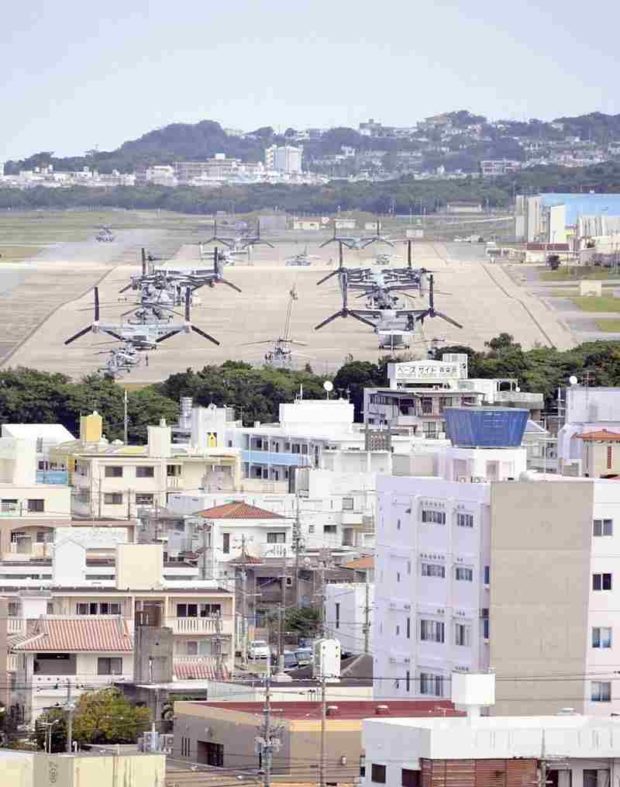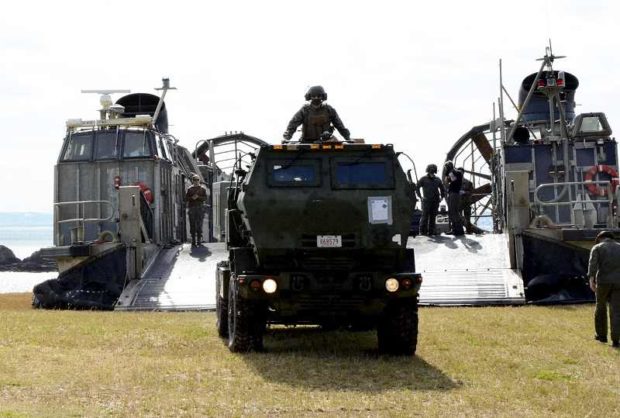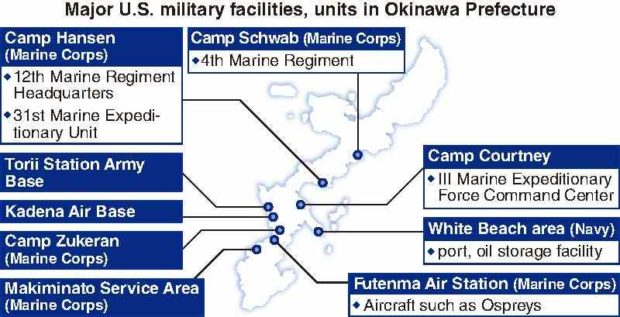Eyeing China, US stresses bridge-building in Okinawa

Yomiuri Shimbun file photo
Osprey transport aircraft are seen parked at the U.S. Futenma Air Station in December 2021.
TOKYO — When U.S. Ambassador to Japan Rahm Emanuel met with Okinawa Gov. Denny Tamaki at the Okinawa prefectural government office on April 27, he told Tamaki that what Japan and the United States do together will shape the next 30 years in the region surrounding Okinawa Prefecture. Emanuel stressed the significance of deepening the Japan-U.S. alliance with a view to deterring China, saying the two countries have a responsibility to cooperate.
It was the first time in about four years and five months that a U.S. ambassador to Japan had met with the Okinawa governor in the prefecture. Emanuel’s visit to Okinawa Prefecture three months after arriving to take up his new post is perceived as showing that the United States is aware of the significance of its military bases in the prefecture and the importance of understanding the local community.
ADVERTISEMENT
The importance of the U.S. military presence in Okinawa is growing. A contingency in the Taiwan Strait has begun to look more and more realistic. Some within Taiwan’s defense ministry believe that China will have the capability to invade Taiwan by 2025.
With a Taiwan Strait contingency looming as a real possibility, the U.S. military is stepping up training based on a new form of expeditionary warfare.
Wildlife photographer gets recognized for photo of PH Eagle in P1,000 bill
PPCRV finds 1.6% mismatch in election returns
‘Vote-buying’ spree drives mobile phone sales
Remote island landing
In February, a landing craft approached from offshore at the U.S. military’s Kin Blue Beach Training Area in the town of Kin. A drill was conducted in a setting where a beach here was a remote island. The boat gliding on the surface of the sea was a U.S. Navy Landing Craft Air Cushion.
With a loud groaning sound, the craft was driven up onto the sandy beach. After landing, the forward part of the craft opened, and a vehicle equipped with a high-mobility rocket launcher system rolled onto the land, ready to fire. It took only about five minutes after landing.
The training exercise was premised on securing a base of operations, including the recapture of an occupied remote island. A senior U.S. Marine Corps official who supervised the training said they are very concerned about a Taiwan contingency. The United States is enhancing its capabilities in preparation for any contingency, he emphasized.
The new type of U.S. military operation is called Expeditionary Advanced Base Operations (EABO). Small units of highly mobile marines will be dispersed to islands within range of the enemy to establish bases for launching anti-aircraft and anti-ship attacks, resupplying and intelligence gathering. EABO missions include sea control operations of the U.S. Navy, dealing with the threat of anti-ship missiles.
The III Marine Expeditionary Force (III MEF), with its headquarters at Camp Courtney Marine Corps Base in the city of Uruma, takes a central role in the new operations.
The 31st Marine Expeditionary Unit with 2,200 troops under the III MEF would be the first unit to rush to the scene in the event of a contingency. It is the only Marine expeditionary unit based outside the United States.
If U.S. forces have left Okinawa, China sees that their deployment to a new position will take time. It will pose a greater risk that China will decide that it has a window in which it can take control of Taiwan. With that scenario in mind, the U.S. Marine Corps announced last December the concept of “stand-in forces,” in which U.S. forces would remain within range of the enemy and serve as a deterrent.
ADVERTISEMENT
“Showing that the U.S. Marines are in Okinawa and can deploy quickly serves as a deterrent, so that China will not become overconfident and miscalculate,” said Kiyofumi Iwata, former Ground Self-Defense Force chief of staff, who is well versed in U.S. military strategy.

Yomiuri Shimbun file photo
A vehicle is driven off a U.S. Landing Craft Air Cushion on a beach in Kin, Okinawa Prefecture, in February.
High relative burden
Yet, there is deep-rooted dissatisfaction among residents of Okinawa Prefecture with the excessive concentration of U.S. military bases there, which has continued since Okinawa’s reversion to Japan in 1972.
Despite the government’s efforts to reduce the burden, 70.3% of the dedicated facilities and areas for U.S. forces in Japan are located in the prefecture, which has only 0.6% of Japan’s total land area. This ratio has increased from 58.7% at the time of the return of Okinawa to Japan, due mainly to the fact that the reversion of such facilities and areas has made greater progress in other parts of the country.
There have been some serious accidents due to intensified drills caused by tensions in the environment surrounding Taiwan and elsewhere.
Also serious is the problem of environmental pollution originating from U.S. military bases. In August 2021, water containing an organofluorine compound — said to have negative health effects — leaked from the U.S. Marine Corps’ Futenma Air Base in the city of Ginowan.
In April of the previous year, fire-extinguishing foam containing the same compound leaked from the same airfield. When the accident occurred last year, Japan and the United States were discussing how to deal with the problem.
Defense Minister Nobuo Kishi protested to the U.S. side, saying, “This is extremely regrettable.”
The United States also recognizes that local understanding is essential for stable base operations.
On April 17, about 130 Japanese and American volunteers, including U.S. military personnel, gathered in Uruma to clean up the beach. Other bridge-building activities include English conversation classes and participation in local sports festivals and traditional events.
Emanuel and senior U.S. military officials are unanimous in saying that the U.S. military should be a good neighbor. Whether and to what extent the Okinawa people can actually accept these words will directly affect the strength of the Japan-U.S. alliance, which is indispensable for the stability of the region and the international community.

The Yomiuri Shimbun
An illustration : Major U.S. military facilities, units in Okinawa Prefecture
RELATED STORIES
Japan’s Okinawa marks half century since US handover as regional tensions grow
Japan’s Okinawa may be on the front lines again as it marks anniversary of US handover
Coronavirus cluster linked to US base in Japan grows to at least 180
Japan’s Okinawa to vote on controversial US base move
Subscribe to our daily newsletter
Read Next
South Korea offers to send vaccines, medical supplies to North Korea
EDITORS’ PICK
MOST READ
Don’t miss out on the latest news and information. 
View comments

